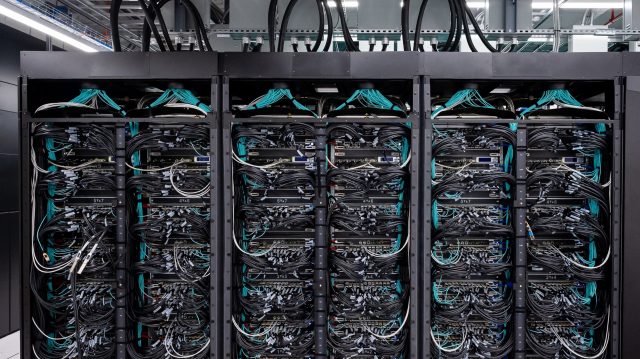
AMD-Powered Supercomputer is The First to Break The Exascale Barrier
Frontier dethroned Japan’s ARM A64X Fugaku system, which has held the top spot the past two years. That system is only capable of 442 Petaflop/s of performance, which means Frontier is more than twice as powerful. It’s such a beast that it’s faster than the next seven supercomputers in the list combined.
The supercomputer is a joint effort between AMD and Hewlett Packard Enterprise (HPE). It runs on the HPE Cray EX235a architecture and is equipped with AMD EPYC 64C processors. It features 74 HPE Cray EX cabinets, and inside those cabinets are more than 9,400 AMD-powered nodes. It has a total of 8,730,112 CPU cores, and features over 90 miles of cabling to connect everything. Data transfer is handled by Gigabit Ethernet. The system is not only the most powerful, it’s also the most efficient as well. It also snagged the top spot on the Green500 list, which measures energy use and efficiency of commercially available supercomputers. It took the top spot with a performance of 62.68 gigaflops performance per watt . It also took the top spot in the new “mixed precision” category, hitting 6.88 Exaflops. This was measured using the HPL-AI test, which measures the speed of calculations used in machine learning and artificial intelligence.

A side view of the Frontier cabinets. (Image: ORNL)
What’s crazy is Frontier isn’t even operating at its peak performance yet, which is a theoretical two Exaflops. It’s been painstakingly assembled by a public-private team of hundred of people. The pandemic slowed things down considerably, but it’s finally up and running. Despite its progress, there’s still a lot more work to do. It still has more testing and validation to do before it’s ready to be actually put to work doing science. Testing will remain ongoing through 2022, with it being available for use in 2023. Once it’s fully operational, it’ll be tasked with running advanced computer simulations. ORNL says it will be used to model cancer cells, supernovas, the coronavirus, or the atomic structure of elements.
If you were wondering about what it takes to run a system like Frontier, here’s some stats. There are 74 cabinets total, and each one weighs 8,000 lbs. The storage system is 700 freaking petabytes, which is 700,000 terabytes. The cooling system moves 6,000 gallons of water through the system each minute using 350hp pumps. Its mechanical plant is rigorous enough to handle the cooling demands for 30,000 homes. Also, if every person on the planet did a calculation at the same time, it would take all of us four years to match what Frontier can do in one second. That’s a powerful computer, no doubt.
The rankings for the world’s top supercomputers at the International Supercomputing Conference in Hamburg, Germany. The rankings are announced twice a year, and Frontier joins other AMD-powered computers at the top of the lists. AMD CPUs power five of the top ten supercomputers, and eight of the top ten most efficient. It also claims 94 systems in the top 500, according to .
Update: An earlier version of this story referred to the supercomputer as Pioneer. The proper name is Frontier. ExtremeTech regrets the error.
Now Read: